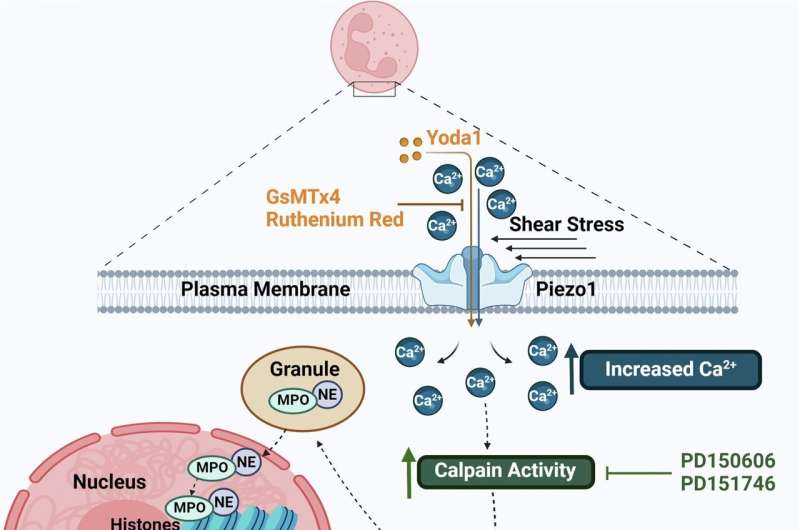This article has been reviewed according to Science X's editorial process and policies. Editors have highlighted the following attributes while ensuring the content's credibility:
fact-checked
peer-reviewed publication
proofread
New insights into blood flow fluctuations offer hope in fight against cardiovascular disease

Researchers have uncovered how fluctuations in blood flow that occur when there is a narrowing in the arteries contribute to harmful inflammation and blood clot formation, revealing the critical role that blood flow–driven forces play in the development and progression of cardiovascular diseases.
These new insights from researchers at the Baker Heart and Diabetes Institute, published today (August 22) in Nature Communications, have led to the identification of a target that could mitigate harmful inflammation and blood clot formation, and potentially have a significant impact on diseases including atherosclerosis and heart valve disease.
When there is a narrowing in blood vessels, blood flow fluctuates and a sequence of cellular events take place, including the activation of white blood cells—the body's innate immune response.
However, the blood flow fluctuation (shear stress) also induces a process called NETosis, which sees white blood cells (neutrophils) release web-like structures that trap and neutralize harmful invaders like bacteria. This trapping and subsequent arterial build-up have been found to contribute to harmful inflammation and blood clot formation.
Baker Institute Head of the Mechanobiology and Microfluidics Lab, Associate Professor Sara Baratchi, has identified that an ion channel called Piezo1 is crucial in the NETosis process, paving the way for the identification of protective treatments to prevent shear stress-induced arterial narrowing.
"Our research has identified that Piezo1 senses the stress that is caused by the blood flow fluctuations, which leads to calcium influx. This, in turn, triggers NETosis and the formation of these white blood cell traps, and the harmful inflammation and clot formation that follows," she said.
"Targeting the Piezo1 ion channel could be a promising therapeutic strategy to mitigate the harmful inflammation and clot formation, which would mean significant potential benefits for public health."
Atherosclerosis is a narrowing of the arteries caused by a buildup of fats, cholesterol and other substances in and on the artery walls and is the underlying cause of about 50% of all deaths in westernized society. It can lead to stroke, heart attacks, dementia, and other health issues.
"Blood flow-driven forces, like shear stress, play a critical role in the development and progression of various cardiovascular diseases, including atherosclerosis and heart valve disease," Sara said.
"Understanding the effect of shear stress in areas where blood vessels or heart valves are narrowed because of the immune cells is crucial in the context of cardiovascular disease, as it offers significant insights into the mechanisms that drive disease progression and complications.
"With these findings, we're now a step closer to identifying protective treatments that can prevent this harmful clotting that is induced by the NETosis process."
More information: Sara Baratchi et al, Piezo1 expression in neutrophils regulates shear-induced NETosis, Nature Communications (2024). DOI: 10.1038/s41467-024-51211-1. www.nature.com/articles/s41467-024-51211-1





















